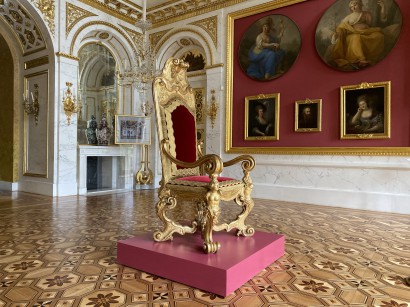

Richly adorned, gold-plated audience throne from the 1st half of the 18th c., which had been used by August II and August III, will be at display in the Palace on the Isle from 2 February to 15 August 2021. The Baroque piece of furniture, adorned with coats of arms of Poland and Saxony, is one of the few preserved throne armchairs from the era of the Polish-Saxon union.
The election of August II as king of Poland in 1697 began a period of over sixty years of close political, economic and cultural ties of Poland and Saxony. The personal union of both states ended with the death of his son August III in 1763.
The times of the Polish-Saxon union are depicted in the iconography of numerous art works created for the court of the House of Wettin. One of them is a richly adorned, golden-plated audience throne from around 1720. The armchair was made for August II and intended for one of the seats of the king in Warsaw or Dresden; it could also be a throne travelling together with the court. It was also used by August III, which is reflected by the rococo coats of arm of Poland and Saxony, sculpted in 1734 in the rear part of the backrest.
Court ceremonial in the 18th century
The fine piece of furniture, currently kept in a private collection, by its artistic and stylistic form reflects the traditions of late Baroque. It was made in one of the leading woodcarving-carpentry workshops working for the Dresden court – by the court sculptor Johann Benjamin Thomae (1651–1732)
The armchair of August II and August III is one of the few preserved throne armchairs from the Polish-Saxon union and it may expand our knowledge of the court ceremonial of the 1st half of 18th century.
The audiences given by the monarch required an appropriate setting defined by the rules of the court ceremonial. In the 18th c. the term "throne" was understood as a whole set of elements consisting of, among other things, a throne armchair, a podium, a canopy and a backrest. Furthermore, the reception room was decorated with symbolic texts referring to virtues and duties of the ruling monarch. As we can read in the lexicon of Johann Heinrich Zedler from 1733, at times when no audience took place, the throne armchair stood turned to the wall, "so as those visiting the room could not sit on it and desecrate that saint seat out of lack of respect or curiosity".
The shape of the throne armchair emphasises its intended purpose which is to serve the monarch ruling by the "Grace of God". The raising of the back with the use of a cartouche with a palmette, placed below the scrollwork and folded flowers of acanthus, is designed to elevate the sitting person and make him or her visible from a distance. The high crowning of the backrest contrasts with the massive chassis of the legs and supports in form of caryatids. The heads of female figures are supported by two powerful armrests, folded in scrollwork; the caryatids embrace the seat as well. The back legs of the throne are visibly bent to take the form of letter "S", ending with large scrollwork. This is precisely the way in which the legs and the armrests are shaped or the soft modelling of the bodies of the caryatids with clearly emphasised waist that depicts the characteristic features of the Dresden Baroque.
The audience throne of the kings of Poland will be displayed in the Salomon Room of the Palace on the Isle from 2 February to 15 August 2021 (from Tuesdays to Thursday between 10.00 and 16.00, and from Friday to Sunday between 10.00 and 18.00). Admission with one combined ticket to all the Museum buildings (PLN 40 – normal ticket, PLN 20 – reduced ticket, PLN 1 – children aged up to 7 years and youth up to 26 years of age).
The patron of the exhibition of the audience throne in the Palace on the Isle is PZU – Patron of the Royal Łazienki Museum.